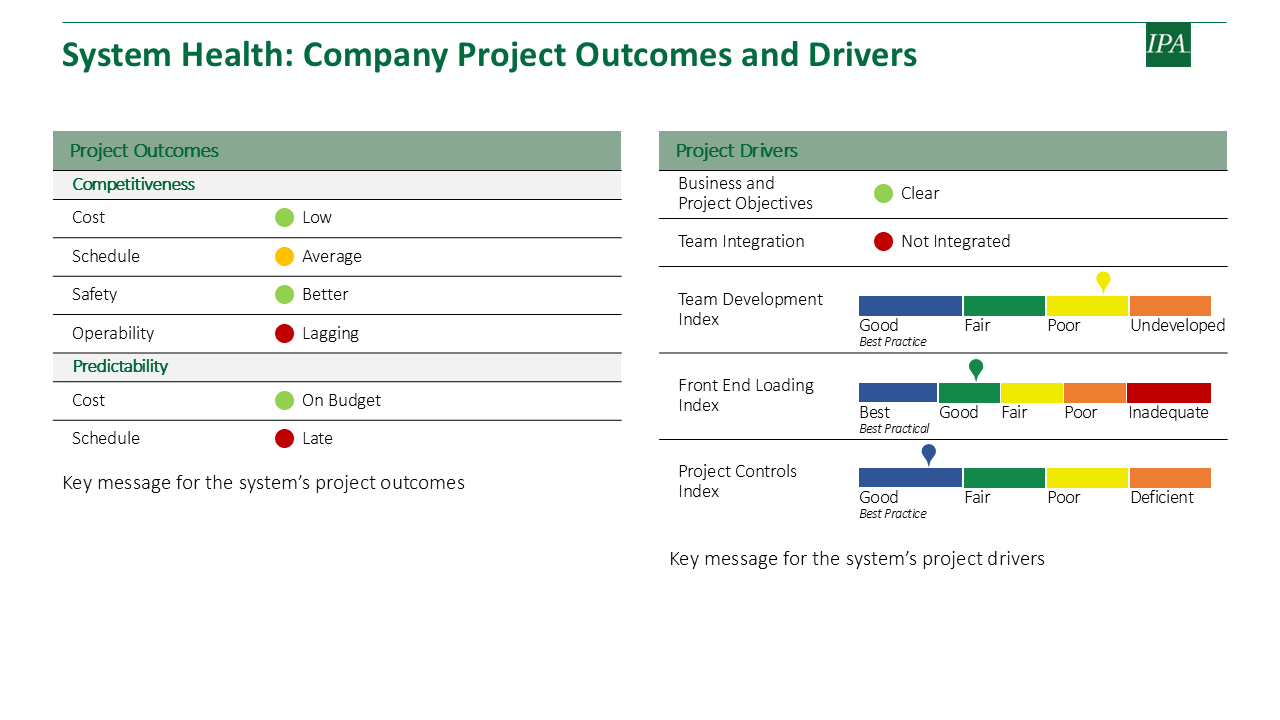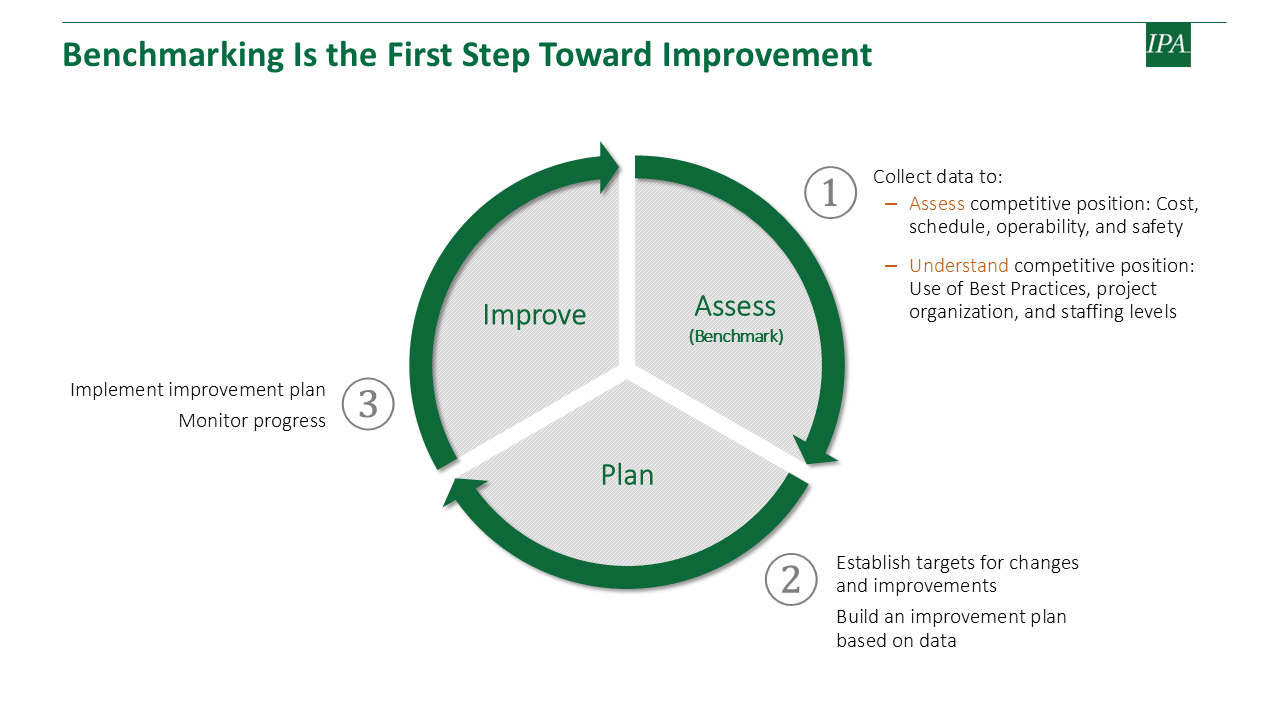IBC Membership: Getting Maximum Value to Drive Continuous Improvement
Throughout IPA’s history working with industrial projects and systems, one of the best indicators that a company has embarked on an ambitious continuous improvement effort is membership in the Industry Benchmarking Consortium (IBC). The IBC currently includes 37 members—owner companies from a range of sectors with diverse portfolios, project organizations, and capital spend.
These companies are at different places in their improvement journeys, with some just starting out and others well along the path. Although IBC member companies have a commitment to continuous improvement in common, they use their IBC membership, including attendance at the annual conference, differently. We set out to find out how members get the most value out of IBC to drive improvements faster.
What Is the IBC?
Established in 1992, the IBC is a premiere group of the world’s leading industrial companies in the processing, refining, infrastructure, chemicals, life sciences, and mining and minerals sectors. IBC member companies actively discuss the latest capital project industry trends and performance hurdles through an annual meeting, competency-focused subcommittees, communities of practice, and periodic webinars. The four founding IBC member companies still retain active membership today, two of which have been members for all 35 years of the IBC.
How Does the IBC Help Companies Improve?
Not all companies that benchmark with IPA are IBC members—but all IBC members are required to benchmark a representative sample of their projects with IPA, to actively participate in the sharing of Best Practices and research, and to set a baseline for continuous improvement.
Through benchmarkings of both large and site-based systems conducted by IPA, IBC member companies receive exclusive insights into how their capital project system performance stacks up against their industry peers with respect to safety, cost, schedule, and operational performance. IPA helps each company to assess the strengths and weaknesses of its project system and map out a plan for improvement.
Why Do Clients Benchmark and Join the IBC?
In interviews with our member clients, we found several reasons for benchmarking with IPA and joining the IBC:
- IPA provides an external view, which is unbiased and can be eye-opening
- CEO requests proof of capital competitiveness from their projects organization
- Project and engineering leaders want an independent, respected voice to convince upper management of performance
- Consortia provides companies with the ability to see the bigger industry picture: Understanding industry trends is crucial, sparking new ideas and ways of thinking
- Assist with developing improvement plans for the next year
Overall, IPA information—both overarching research studies and client-specific metrics—can serve as a starting point for defining, defending, and re-focusing process improvements. We found three main ways member companies improve through benchmarking and IBC membership:
Discovering Best Practices: Research studies and data gathered from project analyses help us to identify what we call Best Practices. IPA defines Best Practices as those that research and experience have shown to produce optimal results and that are suitable for widespread adoption. Best Practices highlight what has worked well in the past and provide real applications that give a path forward for projects and portfolios.
Comparison versus peers: Comparisons both within the company’s sector and outside of the sector show companies where there is room for improvement and what is possible to achieve.
Real-time feedback through metrics and insights: Company-specific metrics provide a snapshot of the current state, help identify root causes of unwanted outcomes, and generate insights on how to adjust and make improvements.

What Are Key Practices for Making the Most of Benchmarking and IBC Membership?
We want member companies to get maximum value out of the IBC to drive their change agenda. As a first step to maximizing value, we developed a set of key practices to set your delegation—and ultimately your company—up for success for the IBC journey.
Start With a Robust Project Sample
A reliable sample of representative projects forms the basis of a company’s current state. This is the only way to ensure an in-depth analysis is done to accurately determine the health of your project delivery system. Benchmarking is the first step to improvement, providing both a performance baseline and data-based reasons for change.

Before the IBC Meeting: Preparing the Delegation
One key practice to maximizing the value of IBC membership is preparing for the annual conference by choosing the employees who can make the most of their time at the meeting. Company attendees should be a cross-functional group, with some consistency from year to year, and representing those who can effect change in your organization. The company’s contingent should include non-project representation like business and should be shaped by the topics on the conference agenda (e.g., a construction manager should attend if there is specific construction content).
Once you have decided who will go, set expectations for what they will accomplish during their time at the conference, including what general and breakout sessions to attend, how they will bring back what they have learned to others in the company, and how they themselves will incorporate learnings.
During the IBC Meeting: Participating for Success
The annual meeting of the IBC provides a wealth of information, from company-specific metrics to broader research findings. The goal is for participants to make the most of their time by fully participating in sessions and by networking with others within and across sectors, as well as with IPA subject matter experts and leaders. Member organizations should also use their individual company breakout session to strategize for change based on key takeaways.
After the IBC Meeting: Turning Learnings Into Action
After the annual meeting, it is critical to share learnings across your organization, for practical application at the project, site, and system levels, as well as to create the case for change with company leadership. To do this, most members centralize general IBC content for larger consumption and then deliver targeted research and findings to specific groups. IPA also provides webinars, which can serve as a refresher for those who attended in person or as a learning opportunity for others in your organization. In other words, the conference itself begins the learning journey, but the learning extends far beyond the meeting, ultimately shaping your company’s continuous improvement efforts and priorities.
This set of key practices gives you an actionable path forward to absorb the content fully and get the appropriate messaging and key issues to the right people in your organization—up, down, and sideways—to decision makers and those who can influence change. The better you are at disseminating important findings and research, the easier it is to implement the right actions to continuously improve.
Still Curious About the IBC and Continuous Improvement?
Submit the form below to start a discussion with IPA about using the IBC to drive your company’s continuous improvement efforts